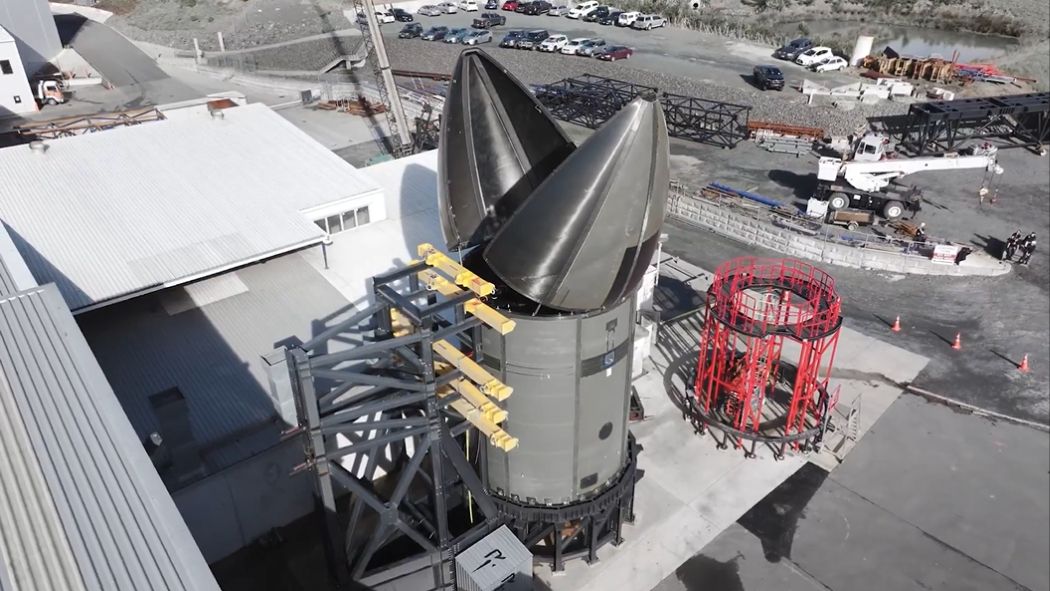ARTICLE AD BOX
American military leaders are speaking more openly than ever about fighting in space — not just defending it.
At the annual Space Symposium last month, senior officials conveyed a sharper posture focused on “space superiority,” a term rooted in military doctrine that means U.S. forces must be able to operate satellites in orbit without interference, and deny that advantage to enemies.
“Space superiority is now a prerequisite for battlefield success,” Gen. Chance Saltzman, the Space Force’s chief of space operations, said in a keynote speech. “So regardless of whether or not you believe space superiority will win the next war, it must be recognized that we will most certainly lose without it.”
After decades of treating space primarily as a support domain for earthbound operations, the new rhetoric reflects a broader transformation in U.S. space strategy, one that increasingly views space as a dynamic, contested domain in which the ability to maneuver — and, if needed, strike — is essential.
“Potential adversaries have realized the unique strategic advantage of space superiority,” Saltzman added, given how much military forces depend on satellites for communication, navigation, surveillance and missile warning. “They know, as we do, that control of the ultimate high ground is critical to success in all the other domains.”
Gen. Stephen Whiting, the new head of U.S. Space Command, put it bluntly: “Without space-based capabilities, the joint force cannot shoot, cannot move and cannot communicate the way they need to at the speed and scale necessary to win on the modern battlefield.”
War in space is not inevitable, said Whiting, “but we must apply our best thinking to be ready. There is no longer any debate that space is a warfighting domain.”
A change in the rhetoric
The military often described space as “congested and contested” — carefully calibrated language that avoided open discussion of offensive capabilities.
Lt. Gen. Shawn Bratton, the Space Force’s deputy chief of space operations for strategy, plans, programs and requirements, acknowledged that the culture has changed. “We’re moving past ‘protect and defend’ and yeah, we’re going to talk about offensive capabilities in space,” he told reporters.
Just days after the Space Symposium, the Space Force released its most explicit blueprint yet for how it plans to defend American satellites — and, if necessary, take aim at enemy space systems — in the event of conflict.
The document, titled “Space Warfighting: A Framework for Planners,” outlines how U.S. forces might assert control of the orbital high ground through a range of offensive and defensive operations, reflecting an evolution in how the military thinks about warfare beyond Earth.
“This document is very specific to space superiority,” said Bratton.
He said the sharpened tone aligns with a broader Pentagon push to instill what military leaders refer to as a “warfighting ethos” — a cultural emphasis on readiness, combat effectiveness and the willingness to engage adversaries directly when necessary.
“We have a new administration that has us very focused on this,” Bratton said. “We’ve got a Secretary of Defense who’s very interested in warfighting ethos and lethality.”
Commercial technology for space dominance
A strategic shift toward space control and superiority, however, will require more than rhetoric. It will also require tangible hardware in orbit. That means deploying systems capable of maneuvering, inspecting and potentially neutralizing other satellites.
Some of the technologies the Space Force is considering for its future arsenal are emerging from the commercial sector, where companies have developed dual-use platforms for satellite servicing, debris removal and space traffic control. Tools such as robotic arms that can grab and relocate spacecraft, autonomous docking and refueling systems, in-space propulsion modules and sensors capable of peering inside satellites can be adapted for defense missions, offering the military a faster and often cheaper path to deploying capabilities that would take years to develop from scratch.
 GITAI’s inchworm robot, designed for in-space servicing, is being eyed for military applications. Credit: GITAI
GITAI’s inchworm robot, designed for in-space servicing, is being eyed for military applications. Credit: GITAIThese technologies are becoming central to how the Pentagon plans to ensure its own access to space — and potentially deny it to others.
“If you can get up close to something and you can touch it to fix it or refuel it, you could just as easily break it or take it somewhere else,” said Brad Head, managing director at the consultancy Elara Nova and a former Space Force officer, speaking on SpaceNews‘ Space Minds podcast. “And industry is able to do that, and is in the process of becoming able to do that. So it’s changing the world.”
Red flags in orbit
In 2021, a Chinese spacecraft known as Shijian-21, equipped with a robotic arm, successfully towed one of China’s dead navigation satellites into a graveyard orbit above the geostationary belt where many of the Pentagon’s vital communications, missile warning and surveillance systems operate. China described Shijian-21 as a debris mitigation system, but U.S. officials viewed it as a potential counter-space weapon.
Russia, meanwhile, has launched “inspector satellites” that maneuver close to U.S. spacecraft — stirring suspicion that they could carry electronic or kinetic warfare payloads aimed at U.S. orbital vehicles.
More recently, Chinese satellites operating in geostationary orbit have conducted maneuvers that raised red flags among U.S. military leaders. Gen. Michael Guetlein, vice chief of space operations for the Space Force, described some of the movements as “dogfighting in space,” a stark characterization that reflects the potential for hostile intent.
While China has said many of these satellites are meant for scientific or peaceful purposes, the dual-use nature of the technologies involved — and a lack of transparency around their capabilities — has deepened U.S. concerns.
Meanwhile, in low Earth orbit, China is dramatically expanding its presence, with plans to launch thousands of satellites as part of two communications megaconstellations.
Though officially billed as commercial ventures, U.S. analysts say there is little clarity around who owns or operates many of these satellites — or what missions they are designed to perform.
“The mission capabilities or payload capabilities are not disclosed,” Eric Eiler, an analyst with the space surveillance firm LeoLabs, said during a briefing at the Space Symposium. “It’s also difficult to discern what satellites are commercial and which are government owned and operated.”
With so many Chinese satellites expected to operate in close proximity to U.S. and allied assets in LEO, the risk of conflict or miscalculation increases, analysts said. If even one of the Chinese spacecraft carried an anti-satellite weapon, locating it would be “like trying to find a needle in a haystack,” Eiler said.
 Starfish Space’s Otter servicing vehicle won a military contract to demonstrate “augmented maneuver” in geostationary orbit. Credit: Starfish Space
Starfish Space’s Otter servicing vehicle won a military contract to demonstrate “augmented maneuver” in geostationary orbit. Credit: Starfish SpaceKari Bingen, senior fellow for defense and security at the Center for Strategic and International Studies, said what is now emerging is a normalization of space as a warfighting domain.
Whiting in his Symposium address was “talking like a warfighter,” Bingen said on the Space Minds podcast. “The thing that General Whiting really hit home was that not only do we need to be talking about our own development and deployment of space weapons, but doing it.”
In years past defense officials were “much more muted” about this subject, said Bingen.
“It could be for classification reasons, for policy reasons,” she said. Just a year or two ago, “you were getting hints of it, as they talked about the need to deny others the use of space, that we need to defend our space assets. Now, those shackles are gone, and they’re not tiptoeing around the need for space weapons.”
A need for new systems that can maneuver
“We had 20 years of peace after the Cold War, where space was incredibly peaceful,” said Col. Joe Roth, director of innovation and prototyping at Space Systems Command.
“So we built constellations that weren’t as resilient as they should be today. A lot of our decisions are driven by what China and Russia are doing on orbit to negate our military capabilities in space and our commercial capabilities in space.”
In response, the U.S. is eyeing commercially developed systems that can maneuver and react quickly, with capabilities to inspect, support or disrupt satellites when needed.
An example is Starfish Space’s “Otter” spacecraft, which received a $37.5 million defense contract last year to demonstrate satellite servicing in geostationary orbit. The Otter will dock with a client satellite and tow it to a “junk belt” for disposal. The same tech could also help to reposition active satellites. “It’s a complex operation and one that should be proven out and make sure it works,” Roth said.
Another emerging system drawing attention is an “inchworm robot” developed by Japanese space firm GITAI, which recently announced plans to expand in the U.S. The robot, designed to crawl across satellites for repairs or inspections, could have defense uses, Roth said. “I see some interesting possibilities with having that capability either grabbing another satellite, pulling it for docking and refueling, or replacing a component on the spacecraft.”
Space Force officials are increasingly candid about such possibilities. “Our potential adversary China is getting bold and aggressive,” Roth said. Their satellite with robotic arms, he noted, “also could grab one of our perfectly good functioning satellites.”
X-ray vision in space
In another example of technology repurposed for defense, ThinkOrbital, a Colorado-based startup originally focused on in-space manufacturing, has been working with the Space Force to adapt its electron-beam tool. That equipment was initially designed for industrial use, to serve as a remote inspection device. By directing x-rays generated by the tool toward a target, ThinkOrbital said it can see inside satellites from as far as 10 kilometers away.
“What we determined is we could also use those x-rays to look inside a spacecraft,” said Justin Chandler, ThinkOrbital’s vice president of government relations. “Whether it was anomaly resolution or something else.”
That capability could be crucial, Chandler said, given U.S. concerns that Russia may be hiding weapons inside satellites. “It would sure be nice to be able to look inside the spacecraft and determine if they put something that is a threat to the United States, our allies and partners.”
The company plans to conduct an in-orbit demonstration in 2026 using two small spacecraft — each capable of emitting and detecting x-rays — to create a flexible inspection system that could be deployed quickly to monitor suspicious satellites.
According to Lt. Gen. Philip Garrant, head of Space Systems Command, on-orbit space domain awareness — especially using systems that can maneuver — is becoming a top acquisition priority. Most current surveillance comes from the ground, he said. “To be effective, they need to be able to maneuver and to fly around and go look at things of interest.”
Such mobility, he said, is central to the U.S. strategy to maintain space superiority.
“You’ve heard Gen. Saltzman talk about the importance of space control,” Garrant said. “Clearly, if we’re going to have an offensive or a defensive capability, it has to be able to maneuver to the target or maneuver to the high-value asset that it’s defending.”
Col. Bryon McClain, who oversees space domain awareness and combat power programs, said studies are underway to identify the next-generation systems that might replace current surveillance satellites like the Geosynchronous Space Situational Awareness Program.
GSSAP satellites face limitations due to fixed fuel supplies, hindering their ability to maneuver freely and perform inspection missions. McClain said it is likely that funding for emerging commercial systems to augment existing capabilities will be sought in future budgets.
Investors see opportunities
While defense programs typically face bureaucratic obstacles, financial backers increasingly view military space capabilities as a bright spot in the commercial space sector’s otherwise cloudy outlook.
Venture capitalists and institutional investors are taking note of the Pentagon’s increased openness about offensive space operations, seeing potential returns despite broader economic headwinds, said Chad Anderson, founder and managing partner of Space Capital, which specializes in early-stage space investments. “The emerging space defense sector represents a rare growth opportunity amid current market uncertainties,” he said April 15.
Anderson pointed to several converging factors making military space applications attractive to investors. “Despite headwinds from tariff policies and potential recession risks, space warfighting stands out as a significant tailwind for the industry.”
Even as other federal agencies face budget constraints, the Pentagon has signaled that space capabilities remain a funding priority, Anderson noted. “You’re going to see far more investment from this administration into that domain, both offensively and defensively.”
This article first appeared in the May 2025 issue of SpaceNews Magazine.

 7 hours ago
2
7 hours ago
2








 English (US) ·
English (US) ·